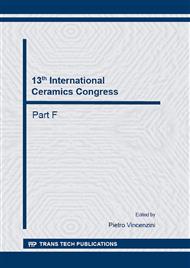p.127
p.133
p.138
p.148
p.159
p.168
p.174
p.184
p.188
Design of a Cool Color Glaze for a Solar Reflective Tile
Abstract:
One of the most common materials-measures to counteract Urban Heat Island Effect can be identified in cool roof: white surface characterized by high solar reflectance and high thermal emissivity. One of the problems for the realization of cool roof is the difficult matching of white color with urban planning needs. In order to better integrate cool roofs into skylines cool colors were developed integrating pigments into cool roof surfaces. Cool roof market is actually dominated by organic based products with optimal solar performances but low durability against ageing. The use of ceramic-based products is crucial in the design of a new durable cool roof thanks to their naturally high thermal emissivity (ε=0.90) and their high chemical durability. The development of a new ceramic-based product made by a traditional porcelain stoneware tile as support, an inorganic engobe was started in the last years. In order to complete the product with a suitable glaze, eight different inorganic pigments were added to three different glazes, each one characterized by different surfaces features. Even if the addition of glazes, and pigments decrease the reflectance values of the solar reflective engobe, some promising results were achieved in this study especially regarding warm colored glazes.
Info:
Periodical:
Pages:
159-167
Citation:
Online since:
October 2014
Authors:
Keywords:
Price:
Сopyright:
© 2014 Trans Tech Publications Ltd. All Rights Reserved
Share:
Citation:


